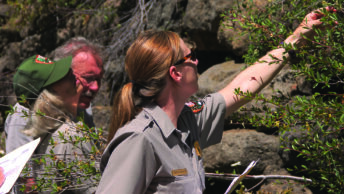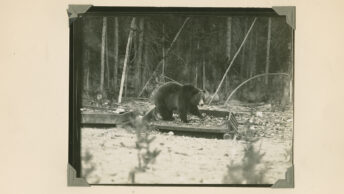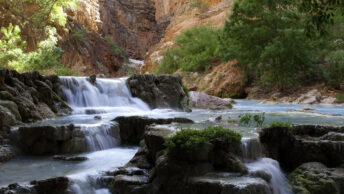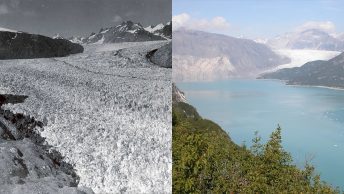Catherine Schmitt, Christy Brigham, Nicholas Fisichelli, Abraham J. Miller-Rushing, Koren Nydick, Tim Watkins, Melanie A. Wood
Abstract
The challenges posed by climate change in national parks
and other protected areas demand creative approaches, new ideas, and
experiments that are beyond the capacity of any single park or agency staff. Research
fellowships provide a critical way that the National Park Service (NPS) and its
partners can address the agency’s needs to address climate change adaptation
challenges. At least 30 such programs support stewardship-relevant science in
national parks. Some national programs and initiatives at Acadia National Park
in Maine, Rocky Mountain National Park in Colorado, and Sequoia and Kings
Canyon National Parks in California serve as examples of how researchers in
these programs are informing restoration, relocation, vegetation and fire
management, and resource protection activities; documenting change that has
already occurred; providing baseline data on biodiversity; and conducting novel
experiments. Successful fellowship programs have strong engagement of resource
managers, emphasize communication with management and public audiences,
and incorporate ongoing support and evaluation. As a result of these successes,
NPS and partners are working to expand and strengthen the sustainability and
effectiveness of research grants and fellowships.
Introduction
Climate change impacts are occurring throughout the national parks, challenging the ability of the National Park Service (NPS) to achieve its mission to preserve unimpaired the country’s natural and cultural resources and values for the enjoyment, education, and inspiration of current and future generations.
Issues are broad in scope, diverse across parks, and demand response. Indeed, for many parks, response and adaptation are no longer items on a future agenda, as the pace of change has shortened timelines for adaptation. Instead of having decades to gather information, plan and execute major research projects and pilot experiments, managers at parks across the system are being forced to confront impacts unfolding in the present.
For example, at Sequoia and Kings Canyon National Parks (SEKI), which encompass an 865,000-acre wilderness, a recent hot drought simulated conditions expected far in the future, affecting giant sequoias to an extent that managers had to promptly initiate managed relocation experiments, while also confronting changes in snowpack, changing bird and plant phenology, and millions of dead trees. Adaptation actions also include reducing stressors not related to climate change (e.g., invasive plants, altered hydrology) whenever and wherever feasible, and assessing vulnerability of habitats in order to prioritize areas for management. The goal is to understand change and take action that enhances resilience and reduces the likelihood of abrupt losses in ecosystem functions such as carbon storage and water cycling (Nydick 2017).
Acadia National Park (ACAD), located in a transition zone between northern boreal and southern temperate forests, similarly faces shifting phenology and ranges of plant and animal species. Changes in climate are also affecting human use patterns in Acadia, with more visitors as the warm season lengthens. Park priorities for climate adaptation include protecting public health as new vector-borne diseases, such as Lyme disease, become more abundant, and planning for large-scale changes in forest composition as insect pests arrive and dominant trees such as red spruce reach the edge of their climate tolerance. Park staff are actively adjusting their approach to planning, resource management, and public engagement, considering various climate scenarios, testing management options, and expanding citizen science programs.
Rocky Mountain National Park (ROMO) seeks to adapt by reducing other stressors, such as nitrogen deposition, invasive species, disease, visitor use impacts, and overbrowsing by elk and moose, and by restoring functioning and resilient ecosystems. Riparian areas are a top priority, as they are biodiversity hotspots; are impacted by overbrowsing and the near-absence of beaver, which have led to incised streams and altered hydrology; and are vulnerable to further stress from climate change, namely in terms of more frequent and severe droughts. Subalpine forests and alpine tundra also are priorities to understand in order to enable informed management to resist or facilitate change.
Managers at these and other parks lack sufficient capacity to adequately quantify, monitor, mitigate, and respond to all the ongoing changes. They need more information more quickly than in the past, often about problems previously not encountered. Research fellowships are one way to increase the ability of managers to understand and adapt to climate change, develop and strengthen relationships with research institutions, and cultivate the current and future generations of scientists—a key priority of the natural resource science and stewardship programs of NPS.
Through research fellowships, NPS and its partners can address the agency’s needs for capacity and creativity to address climate change adaptation challenges. As case examples, we focus on some national programs and also on initiatives at ACAD, ROMO, and SEKI.
Research fellowships as an approach
A review of park and park partner websites revealed some 30 grant and fellowship programs for management-relevant science, ranging from national efforts (e.g., Conway Fellowships and Second Century Stewardship) to local and regional programs for individual parks. Only a few explicitly focus on climate change, but most support climate research given the severity of climate change and its impacts on the national parks. Internship programs meet many of the same needs through a different framework, and can be complementary to fellowships. The Future Park Leaders of Emerging Change program (FPL), successor to the George Melendez Wright Climate Change Fellowship Program (CCFP), supports highly rigorous internships that are similar in complexity to fellowships, but smaller in scope.
The fellowship programs have diverse goals. Some are aimed primarily at solving priority questions to inform management, whereas others (perhaps most) also aim to cultivate relationships with researchers and students. Some fellowships also have strong communication goals, whether to tell the stories of the specific research projects they fund or to help the fellows themselves develop skills as communicators and science storytellers. Several programs cited here function as leadership development, providing potential pathways for eventual employment across federal land management agencies, building the agency capacity necessary to bring relevant skills and knowledge to bear on management issues. Additionally, many programs seek to advance the representative diversity within all aspects of the NPS workforce to better reflect the demographics of our nation.
A typical fellowship program provides funding for one year or a single field season (Conway Fellowships are a three-year grant) although projects often take longer than one year to complete (see Table 1). Awards range from $1,000 to $30,000 annually, with most in the $5,000 to $10,000 range. Parks often supplement the financial awards with in-kind services such as subsidized housing, transportation, administrative services, and professional assistance. In all of the examples presented here, park staff are involved in reviewing proposals and applications to ensure maximum impact on management.

Table 1. Selected national park research fellowship programs.
Funding varies, but most programs are limited in the number of awards they can make not by the quality of proposals received, but by the amount of funding available. The Rocky Mountain Fellowship is an endowed program funded by the Leslie Fidel Bailey Charitable Trust; Second Century Stewardship was made possible by a major donation from the David Evans Shaw Family Foundation. At SEKI, the fellowship program is funded primarily through park base funding provided to the Resources Management and Science Division.
Examples of climate adaptation informed by fellowship research
Decades of research in ROMO have documented a decline in riparian ecosystem health, and pointed to the need for restoration. In 2019 a ROMO mini-grant was awarded to Dr. David Cooper and a team of NPS scientists and other collaborators to pilot-test simulated beaver structures as a way to increase water table levels, speed the recovery of overly browsed riparian ecosystems, and eventually attract beaver to these areas. Also in 2019, Isabel Schroeter received a Bailey Fellowship to study water limitation in the park’s riparian plant species. These studies have included measuring the impact on willow communities of ungulate browsing and disease, understanding the relationship between hydrology and riparian vegetation, and developing methods to quantify riparian canopy structure. Results have informed decisions regarding elk and vegetation management actions, such as installing ungulate exclosures, elk culling, willow planting, and selecting monitoring methods (NPS 2008) as well as spurring new research on the growing moose population and its impacts. While the research, monitoring, and management required to restore riparian ecosystems were not originally proposed as climate change research, the park now sees them as a key climate adaptation strategy.
As a result of changing climate conditions, species ranges are shifting rapidly in the mountains of SEKI. Investigating methods for actively relocating species, SEKI fellow Dr. Emily Moran and an undergraduate research assistant conducted experimental plantings of different conifer trees that currently grow within the parks in areas within and outside their current ranges, and will be measuring tree growth and survival over the next several years. This pilot managed-relocation experiment addressed one of SEKI’s highest-priority research needs and improved information exchange between researchers and park staff.
What about trees that grow in unique environments? Are they doomed if those environments change, or is flexibility inherent to their uniqueness? Lodgepole pine can be found in a range of extreme conditions, from the coast of California to the treeline of the Sierras and dry slopes of the Rockies. With support from the CCFP, Dr. Sarah Bisbing assessed genetic variation within and among four subspecies of lodgepole pine from different areas, and conducted a reciprocal transplant experiment to understand the trees’ adaptive abilities, aiding predictions of lodgepole pine’s performance in novel environments. Moreover, information on population structure will enable managers at Glacier, Yellowstone, and Yosemite national parks to preserve unique populations—and high levels of variation—across the landscape, providing the pine with the opportunity to persist in a changing climate.
Persistence is behind the concept of climate refugia: areas that for various reasons do not change as rapidly as the surrounding landscape and may provide refuge for some plants and animals. Second Century Stewardship (SCS) Fellow Dr. Jennifer Smetzer worked with managers from federal and state agencies and land trusts from the ACAD region to identify species of concern that might benefit from climate refugia. In an iterative process, she used data on the species, landscape conditions, and future climate to identify potential refugia areas, and shared draft maps with managers for validation and to help them develop plans for adjusting management. Her project is now being scaled up to address landscapes around national parks throughout the Northeast region.
Temperature is a limiting factor for cold-water fish such as brook trout, which find refuge in cold groundwater-fed pools or tributaries during hot summer months. Identifying such areas can inform NPS plans to protect, restore, and manage brook trout habitat in the face of a changing climate. At Namekagon River, part of St. Croix National Scenic Riverway, CCFP Fellow Dr. Patrick Shirey deployed 95 temperature loggers and surveyed fish populations in tributaries to determine current refugia. Shirey’s research on the history of the river to determine probable causes for the decline of brook trout revealed a gap in historical temperature data, demonstrating the need for systemwide temperature measurements. His review of historical records showed that brook trout were abundant in the mainstem of the Namekagon River but declined soon after logging began in the late 1800s.
Historical records provide baseline information that can help scientists document change that has already occurred, or understand the current status of resources so they can design adaptation actions. Resampling existing datasets is a high-priority research need for many parks that rarely have the staff or resources to undertake such work. At SEKI, three fellows are resampling high-elevation and rare plant communities that are expected to be vulnerable to climate change due to limited distributions. The findings will indicate which species and habitats are especially affected by a changing climate.
Through a series of grants to researchers studying disturbance regimes and change in subalpine forests, ROMO managers learned that the historical fire regime over the last several centuries has been characterized by large stand-replacing fires at intervals from 291 to 366 years (during periods of extreme drought), and that over the last 7,000 years fire frequency increased with warming temperatures (Caffrey and Doerner 2012). Researchers also found that contemporary high stand densities of subalpine forests are consistent with historical fire regimes, contradicting the notion that thinning subalpine forests mimics fire and returns fuel conditions to a more “natural” state (Sibold et al. 2006). Other researchers have found that even though fire suppression and climate change may have encouraged an epidemic of tree-killing mountain pine beetle whose infestations caused extensive changes to the subalpine forest ecology, the number of surviving trees, increased heterogeneity of the forest, and viability of seed will support forest recovery and increased resistance in the face of future outbreaks (Rocca et al. 2014; Renwick et al. 2016). As a result of this information, along with climate change projections, managers expect continued—and likely more frequent—stand-replacing fires in subalpine forests, and will be able to respond more appropriately to beetle outbreaks through planting and fire management programs.
In ACAD, SCS Fellow Dr. Allison Gardner studied the effects of fire and other landscape features on the ecology of ticks and tick-borne diseases, such as Lyme disease, which has become a major public health concern across much of the northeastern United States. She identified areas of high risk for tick exposure (which include some of the most-visited parts of the park), and as a result park staff are already altering management and communication strategies to protect public health and safety.
Park staff can’t manage resources if they don’t know what they are. Getting a glimpse of park biodiversity is now possible with genetic tools such as environmental DNA (eDNA), which allows for more efficient sampling of species distributions across large landscapes. A vial of water or soil contains numerous fragments of life that can be analyzed for their unique species signature. SEKI fellow Dr. Joshua Reece and his undergraduate students (Figure 1) conducted eDNA sampling of aquatic communities within the park, based on a list of species of concern (both native and invasive) developed with NPS biologists. The project helped form a new and potentially long-lasting relationship with a local university with a diverse student body, and provided an updated dataset that can be used to determine climate-related changes in aquatic communities.
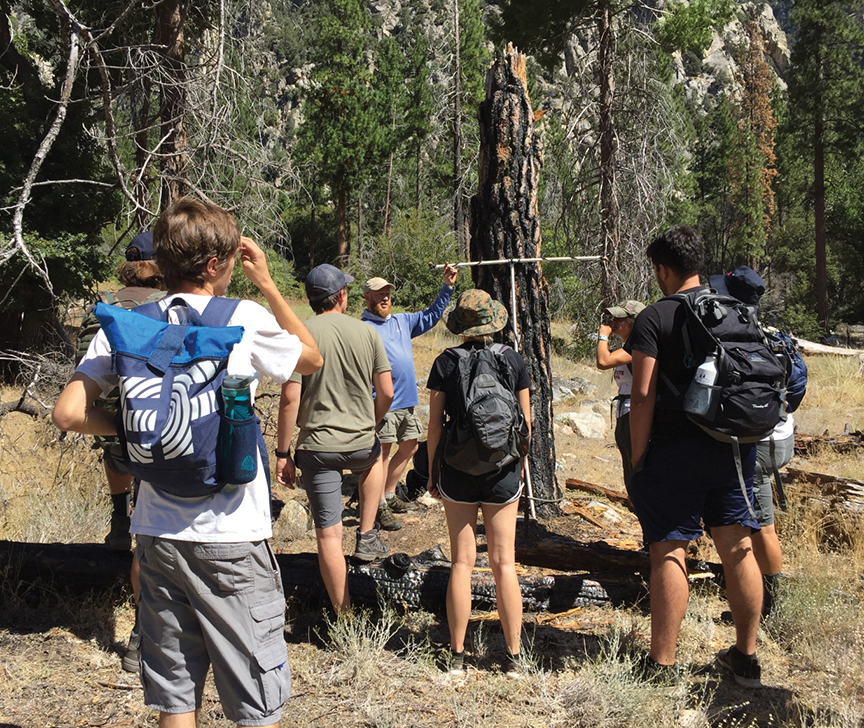
SCS Fellow Dr. Abby Paulson used eDNA to conduct a similar study of biodiversity in lakes and streams in ACAD. Her surveys identified more than 2,533 species (or more accurately, operational taxonomic units given that they were identified through eDNA), most of which were previously unknown in the park. She also used eDNA techniques to assess the effectiveness of management actions designed to improve stream connectivity by removing dams and changing culvert designs, which are widespread climate adaptation strategies for streams everywhere. She found that the managed streams had strong taxonomic connectivity up- and downstream of the removed barriers.
While some of these projects were designed to study climate change, many of the projects that are helping managers address climate change were not originally proposed for that purpose. Some were funded under the goals of ecosystem restoration or biodiversity conservation, such as the ROMO riparian and forest ecology studies described above, as well as other research in ROMO to inform recovery programs for the endangered boreal toad and threatened greenback cutthroat trout. Other ROMO mini-grants were funded specifically because of the vulnerability of iconic alpine species (American pika and white-tailed ptarmigan) to climate change. Awards to Dr. Chris Ray and Dr. Cameron Aldredge have provided park managers with information about status and trends, interacting stressor effects, and potential future scenarios for these species, while also providing for educational opportunities for their students and supporting implementation of a citizen-science pika monitoring project in the park and beyond.
Research fellowships also allow for creative experimentation that NPS managers (and most scientists) would generally not consider. In ACAD, for example, SCS Fellow Chris Nadeau identified a natural model ecosystem: freshwater pools along the rocky coastline that host communities of invertebrates that can be studied and manipulated in much the same way as a laboratory mouse or zebrafish (Figure 2). In addition to studying the natural pools, Nadeau altered temperature and precipitation in artificial pools to test managed relocation, and to assess community dynamics and even evolution. His findings will inform management practices and models of more complex interactions. This is an example of the creativity and innovation that fellowships can attract and foster.

Characteristics of successful fellowship projects
Strong connections with resource managers and their needs. The most successful projects are tied to resource management priorities and aligned with management timelines and decisionmaking. In the case of SEKI, an easily accessible research prospectus (SEKI 2018) helps researchers understand the questions that the parks want answered most. Making a proposal’s relevance to identified research needs part of the scoring criteria for the fellowship has also helped target research.
Instructions for ROMO’s grant program emphasize the need to focus scientific questions on a decisionmaking or educational need, and to collaborate with park staff. Researchers who spend more effort in working with ROMO staff to develop proposals tend to be more successful in being awarded funds.
CCFP fellows in more than 50 parks worked closely with resource managers in the design and conduct of their research, and communicated their findings and recommendations to park managers as part of their fellowship. Graduate student proposals were required to have the endorsement of resource management leaders in the park being studied.
These fellow–manager relationships are critical to fostering future climate adaptation science. Fellows develop a lifelong passion for and commitment to national park science. Fellows can develop future research projects and programs that more directly address key management issues, while providing guidance to managers who don’t have the time to access, read, and synthesize the ever-growing volume of scientific literature.
Emphasis on communication and engagement. Communication is critical to ensuring that managers understand how to apply science to real-world problems and that public audiences glimpse the joys and wonders of scientific discovery and the importance of science to the shared stewardship of national treasures. Thus, fostering science communication is another key priority of NPS natural resource science and stewardship programs. Fellowships that include a science communication component are increasingly valuable for all parties.
Many of today’s graduate students and early-career scientists are very interested in communicating science to public audiences, and practice their craft in both formal and informal settings through presentations, traditional media, social media, informal events such as science cafes, and interactions with school teachers. Communication is a major component of several of the fellowship programs highlighted here. SEKI researchers present at an annual science symposium and in a brown bag lunch presentation open to all staff.
The Bailey Research Fellowship of the Rocky Mountain Conservancy supports graduate students conducting research in ROMO, but it is also intended to convey the importance of communicating park research, and thus supports fellows who exhibit the ability to communicate effectively to public audiences. Research fellows are responsible for providing a seminar for park staff after their field season, and a public program through Rocky Mountain Conservancy’s Field Institute the following summer. ROMO grant recipients share results via a biennial research conference, research briefs, seminars, and field trips.
One of the primary goals of SCS is to enhance science communication to inspire and inform stewardship of our natural and cultural heritage, as well as leverage park science to enhance learning and engagement for students, educators, and the broader public. SCS fellows participate in multiday science communication workshops that include theory, social science research findings, understanding audiences, and crafting and framing messages and communication strategies. To date, SCS partners have offered 10 workshops for science communication and citizen science. Fellows are required to develop a communications plan as part of their fellowship. Fellows have learned about interacting with journalists and editors, best practices for establishing a social media-based crowdsourced data collection effort, personal storytelling, and overcoming barriers to knowledge exchange. The communications component of SCS has expanded beyond ACAD and is being integrated with research in parks across the system.

Ongoing support and inspiration. While fellowships may only last a year, the relationship among fellows, research institutions, and tenured faculty often persists. Fellows build affinities for national parks, and with those affinities the possibilities of developing research programs in these special places, and continued enthusiasm for and engagement in parks. Fellowships are also successful when they leverage partnerships. Nonprofit partners assist with requests for proposals, processing and awarding fellowships, and communication of research activity and results to the public. Small-grant programs from parks or friends groups can help to sustain relationships with early-career researchers, acting as bridge funds until larger grants can be obtained.
For example, Dr. Sarah Nelson was a scholar in the Canon National Parks Science Scholars Program (which began in 1997 and continued through 2007) who worked in ACAD as a doctoral student and has continued her research program in the park with varied funding sources, including small grants from Schoodic Institute. Most recently she founded the Dragonfly Mercury Project, a citizen-science effort that has since expanded to more than 100 parks.
A number of CCFP and FPL alumni have taken federal, state, county, and municipal jobs related to climate change. For example, 2017 FPL intern Shanasia Sylman helped assess the relative vulnerability of Derby Wharf at Salem Maritime National Historic Site and established citizen-science monitoring protocols for the structure (Figure 3). Following her graduation, Sylman was conferred direct hire authority and was subsequently hired by the NPS Denver Service Center as a park planner. In this new role, Sylman assists parks across the country consider the effects of climate change in their long-range planning.
Because fellowships are typically a one-time award, researchers must work to secure additional support. Sometimes this happens through multiple fellowships. For example, as a graduate student at Boston University, Dr. Caitlin McDonough MacKenzie received a CCFP fellowship in 2011 to study changes in plant species diversity and phenology (the timing of life-cycle events such as flower production) in ACAD. That experience cemented her connection to the park, where she has continued her studies as a graduate student and postdoctoral researcher. Her work has been supported through multiple fellowships, including a recent award under the SCS program.
Follow-through with fellows is about more than tracking outcomes of individual fellowships or research projects. Preparing, adapting, and responding to climate change is a complex problem that requires a series of programs and projects to inform on-the-ground management decisions. It’s a multichaptered story that builds over time and is both an interpretive opportunity and challenge to convey the importance of how science builds knowledge for informing decisions. Evaluation and reporting are important to show a program’s worth over time, and need to be planned for in terms of time, funding, and other support, to ensure adaptive management of the program itself.
Follow-through is also important for communication and engagement activities. The SCS program works with fellows to support the implementation of their communications plans and follows alumni to evaluate and improve the effectiveness of communication training.
Conclusion
The National Park Service has a long-standing commitment to conducting, supporting, and facilitating science in order to understand and manage the nation’s protected resources. That commitment is embodied in official policy (NPS 2006) and its underlying laws, as well as in strategic frameworks that guide NPS in pursuing its mission (e.g., NPS 2016). But managing large landscapes, and human visitors to them, is a challenging task made more difficult by the pace and scope of global climate change.
Most managers do not have the staff, money, expertise, equipment or existing datasets to adequately evaluate and respond to climate change. Building stronger academic collaborations is one of the only avenues available to address these shortfalls. Even where capacity exists within a park, research partnerships can increase the amount, variety, and creativity of potential solutions. As illustrated by the examples presented here, strategic fellowship programs can be an extremely effective way to develop new and existing relationships and support students and early-career scientists while meeting resource stewardship goals.
Catherine Schmitt, Schoodic Institute at Acadia National Park
Christy Brigham, Sequoia and Kings Canyon National Parks
Nicholas Fisichelli, Schoodic Institute at Acadia National Park
Abraham J. Miller-Rushing, Acadia National Park
Koren Nydick, Rocky Mountain National Park
Tim Watkins, National Park Service
Melanie A. Wood, Climate Change Response Program, National Park Service
Corresponding author
Catherine Schmitt
Schoodic Institute at Acadia National Park
P.O. Box 277
Winter Harbor, ME 04693
cschmitt@schoodicinstitute.org
References
Caffrey, M.A., and J.P. Doerner. 2012. A 7000-year record of environmental change, Bear Lake, Rocky Mountain National Park, USA. Physical Geography 33(5): 438–456.
NPS [National Park Service]. 2006. Management Policies 2006. Washington, DC: NPS. https://www.nps.gov/policy/mp/policies.html
NPS. 2008. Elk and Vegetation Management Plan. Estes Park, CO: NPS.
NPS. 2016. National Park Service Natural Resource Stewardship and Science Framework. Washington, DC: NPS.
Nydick, K., ed. 2017. A Climate-Smart Resource Stewardship Strategy for Sequoia and Kings Canyon National Parks. Three Rivers, CA: National Park Service.
Renwick, K.M., M.E. Rocca, and T.J. Stohlgren. 2016. Biotic disturbance facilitates range shift at the trailing but not the leading edge of lodgepole pine’s altitudinal distribution. Journal of Vegetation Science 27(4): 780–788.
Rocca, M.E., P.M. Brown, L.H. MacDonald, and C.M. Carrico. 2014. Climate change impacts on fire regimes and key ecosystem services in Rocky Mountain forests. Forest Ecology and Management 327: 290–305.
SEKI [Sequoia and Kings Canyon National Parks]. 2018. Find Your Science: A Research Prospectus for Sequoia and Kings Canyon National Parks. Three Rivers, CA: NPS.
Sibold, J.S., T.T. Veblen, and M.E. González. 2006. Spatial and temporal variation in historic fire regimes in subalpine forests across the Colorado Front Range in Rocky Mountain National Park, Colorado, USA. Journal of Biogeography 33(4): 631–647.




